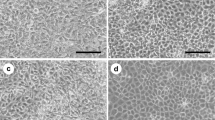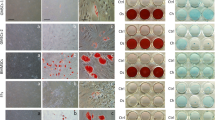Abstract
The establishment of a method to derive dental epithelial cells seems to be an important challenge toward realizing the whole tooth regeneration. In order to obtain a source of dental epithelial-like cells, a new methodology has been previously developed by our research group. In the method, induced pluripotent stem cells are cultured in suspension in the presence of neurotrophin-4 to form embryoid bodies followed by further adherent culture of the embryoid bodies in DMEM basal nutrient medium. The present study was directed to improve the efficiency of dental epithelial-like cell production, by focusing on the optimization of initial cell number for the formation of embryoid bodies and the addition of epidermal growth factor as well as its timing. Our results demonstrated that an initial cell number of 1000 cells/drop gives the highest efficiency of dental epithelial-like cell production. It appears that, under this condition, medium deterioration is moderated, and that cell-cell interactions are optimized within embryoid bodies. On the other hand, epidermal growth factor serves to increase the abundance of dental epithelial-like cells when added to the medium together with neurotrophin-4 during embryoid body formation. The promotive effect of epidermal growth factor may involve the transactivation of TrkB, mediated by the effectors of epidermal growth factor receptor signaling.



Similar content being viewed by others
References
Abdullah AN, Miyauchi S, Onishi A, Tanimoto K, Kato K (2019) Differentiation of mouse iPS cells into dental epithelial-like cells in the absence of added serum. In Vitro Cell Dev Biol Anim 55:130–137
Arakaki M, Ishikawa M, Nakamura T, Iwamoto T, Yamada A, Fukumoto E, Saito M, Otsu K, Harada H, Yamada Y, Fukumoto S (2012) Role of epithelial-stem cell interactions during dental cell differentiation. J Biol Chem 287:10590–10601
Bartlett JD, Ganss B, Goldberg M, Moradian-Oldak J, Paine ML, Snead ML, Wen X, White SN, Zhou YL (2006) Protein-protein interactions of the developing enamel matrix. Curr Top Dev Biol 74:57–115
Bluteau G, Luder HU, Bari CD, Mitsiadis TA (2008) Stem cells for tooth engineering. Eur Cell Mater 16:1–9
Boonstra J, Rijken P, Humbel B, Cremers F, Verkleij A, van Bergen en Henegouwen P (1995) The epidermal growth factor. Cell Biol Int 19:413–430
Bratt-Leal AM, Carpenedo RL, McDevitt TC (2009) Engineering the embryoid body microenvironment to direct embryonic stem cell differentiation. Biotechnol Prog 25:43–51
Cai J, Zhang Y, Liu P, Chen S, Wu X, Sun Y, Li A, Huang K, Luo R, Wang L, Liu Y, Zhou T, Wei S, Pan G, Pei D (2013) Generation of tooth like structure from integration-free human urine induced pluripotent stem cells. Cell Regen. (Lond.) 2: 6
Carpenter G, Cohen S (1990) Epidermal growth factor. J Biol Chem 265:7709–7712
Cohen S (1962) Isolation of a mouse submaxillary gland protein accelerating incisor eruption and eyelid opening in the new-born animal. J Biol Chem 237:1555–1562
Colin R, Steven JB, Roger CS, Jennifer K (1998) The developing enamel matrix: nature and function. Eur J Oral Sci 106:282–291
Couwenhoven RI, Snead ML (1994) Early determination and permissive expression of amelogenin transcription during mouse mandibular first molar development. Dev Biol 164:290–200
Domingues MG, Jaeger MM, Araujo VC, Araujo NS (2000) Expression of cytokeratins in human enamel organ. Eur J Oral Sci 108:43–47
Duailibi MT, Duailibi SE, Young CS, Bartlett JD, Vacanti JP, Yelick PC (2004) Bioengineered teeth from cultured rat tooth bud cells. J Dent Res 83:523–538
Gupta R, Chaudhary M, Patil S, Fating C, Hande A, Suryawanshi H (2019) Expression of p63 in tooth germ, dentigerous cyst and ameloblastoma. J Oral Maxillofac Pathol 23:43–48
Herbst RS (2004) Review of epidermal growth factor receptor biology. Int J Radiat Oncol Biol Phys 59:21–26
Honda MJ, Tsuchiya S, Sumita Y, Sagara H, Ueda M (2007) The sequential seeding of epithelial and mesenchymal cells for tissue-engineered tooth regeneration. Biomaterials 28:680–689
Hu JC, Sun X, Zhang C, Simmer JP (2001) A comparison of enamelin and amelogenin expression in developing mouse molars. Eur J Oral Sci 109:125–132
Ikeda E, Morita R, Nakao K, Ishida K, Nakamura T, Takano-Yamamoto T, Ogawa M, Mizuno M, Kasugai S, Tsuji T (2009) Fully functional bioengineered tooth replacement as an organ replacement therapy. Proc Natl Acad Sci U S A 106:13475–13480
Inage T, Shimokawa H, Teranishi Y, Iwase T, Toda Y, Moro I (1989) Immunocytochemical demonstration of amelogenins and enamelins secreted by ameloblasts during the secretory and maturation stages. Arch Histol Cytol 52:213–229
Kajiwara M, Aoi T, Okita K, Takahashi R, Inoue H, Takayama N, Endo H, Eto K, Toguchida J, Uemoto S, Yamanaka S (2012) Donor-dependent variations in hepatic differentiation from human-induced pluripotent stem cells. Proc Natl Acad Sci U S A 109:12538–12543
Kim EJ, Yoon KS, Arakaki M, Otsu K, Fukumoto S, Harada H, Green DW, Lee JM, Jung HS (2018) Effective differentiation of induced pluripotent stem cells into dental cells. Dev Dyn 248:129–139
Kurosawa H (2007) Methods for inducing embryoid body formation: in vitro differentiation system of embryonic stem cells. J Biosci Bioeng 103:389–398
Lacruz RS, Habelitz S, Wright JT, Paine ML (2017) Dental enamel formation and implications for oral health and disease. Physiol Rev 97:939–993
Lee FS, Chao M (2001) Activation of Trk neurotrophin receptors in the absence of neurotrophins. Proc Natl Acad Sci U S A 98:3555–3560
Li S, Ge S, Yang P (2015) Expression of cytokeratins in enamel organ, junctional epithelium and epithelial cell rests of Malassez. J Periodontal Res 50:846–854
Liu L, Liu YF, Zhang J, Duan YZ, Jin Y (2016) Ameloblasts serum-free conditioned medium: bone morphogenic protein 4-induced odontogenic differentiation of mouse induced pluripotent stem cells. J Tissue Eng Regen Med 10:466–474
Malhotra N (2016) Induced pluripotent stem (iPS) cells in dentistry: a review. Int J Stem Cells 9:176–185
Medawar A, Virolle T, Rostagno P, de la Forest-Divonne S, Gambaro K, Rouleau M, Aberdam D (2008) ΔNp63 is essential for epidermal commitment of embryonic stem cells. PLoS One 3:e3441
Mitsiadis TA, Pappagerakis P (2001) Regenerated teeth: the future of tooth replacement? Regen Med 6:135–139
Ning F, Guo Y, Tang J, Zhou J, Zhang H, Lu W, Gao Y, Wang L, Pei D, Duan Y, Jin Y (2010) Differentiation of mouse embryonic stem cells into dental epithelial-like cells induced by ameloblast serum-free conditioned media. Biochem Biophys Res Commun 394:342–247
Oshima M, Mizuno M, Imamura A, Ogawa M, Yasukawa M, Yamazaki H, Morita R, Ikeda E, Nakao K, Takano-Yamamoto T, Kasugai S, Saito M, Tsuji T (2011) Functional tooth regeneration using a bioengineered tooth unit as a mature organ replacement regenerative therapy. PLoS One 6:e21531
Osman H, Kora AS (2006) Immunohistochemical detection of cytokeratin 14 in developing enamel organ of rat molars. Egyptian Dent J 52:1399–1407
Otsu K, Kishigami R, Oikawa-Sasaki A, Fukumoto S, Yamada A, Fujiwara N, Ishizeki K, Harada H (2012) Differentiation of induced pluripotent stem cells into dental mesenchymal cells. Stem Cells Dev 21:1156–1164
Otsu K, Kumakami-Sakano M, Fujiwara N, Kikuchi K, Keller L, Lesot H, Harada H (2014) Stem cell sources for tooth regeneration: current status and future prospects. Front Physiol 5:36
Polo JM, Liu S, Figueroa ME, Kulalert W, Eminli S, Tan KY, Apostolou E, Stadtfeld M, Li Y, Shioda T, Natesan S, Wagers AJ, Melnick A, Evans T, Hochedlinger K (2010) Cell type of origin influences the molecular and functional properties of mouse induced pluripotent stem cells. Nat Biotechnol 28:848–855
Puehringer D, Orel N, Lüningschrör P, Subramanian N, Herrmann T, Chao MV, Sendtner M (2013) EGF transactivation of Trk receptors regulates the migration of newborn cortical neurons. Nat Neurosci 16:407–415
Rajagopal R, Chao MV (2006) A role for Fyn in Trk receptor transactivation by G-protein-coupled receptor signaling. Mol Cell Neurosci 33:36–46
Rufini A, Barlattani A, Docimo R, Velletri T, Niklison-Chirou MV, Agostini M, Melino G (2011) p63 in tooth development. Biochem Pharmacol 82:1256–1261
Sakurai M, Hayashi R, Kageyama T, Yamato M, Nishida K (2011) Induction of putative stratified epithelial progenitor cells in vitro from mouse-induced pluripotent stem cells. J Artif Organs 14:58–66
Snead ML, Paine ML, Luo W, Zhu DH, Yoshida B, Lei YP, Paine CT, Chen LS, Burstein JM, Jitpukdeebudintra S, White SN, Bringas P Jr (1998) Transgene animal model for protein expression and accumulation into forming enamel. Connect Tissue Res 38:279–286
Sonoyama W, Liu Y, Fang D, Yamaza T, Seo BM, Zhang C, Liu H, Gronthos S, Wang CY, Wang S, Shi S (2006) Mesenchymal stem cell-mediated functional tooth regeneration in swine. PLoS One 1:e79
Tabata MJ, Matsumura T, Liu JG, Wakisaka S, Kurisu K (1996) Expression of cytokeratin 14 in ameloblast-lineage cells of the developing tooth of rat, both in vivo and in vitro. Arch Oral Biol 41:1019–1027
Takahashi K, Yamanaka S (2006) Induction of pluripotent stem cells from mouse embryonic and adult fibroblast cultures by defined factors. Cell 126:663–676
Ten Cate AR (1996) The role of epithelium in the development, structure and function of the tissues of tooth support. Oral Dis 2:55–62
Uchida T, Tanabe T, Fukae M (1989) Immunocytochemical localization of amelogenins in the deciduous tooth germs of the human fetus. Arch Histol Cytol 52:543–552
Wong RW, Guilland L (2004) The role of epidermal growth factor and its receptors in mammalian CNS. Cytokine Growth Factor Rev 15:147–156
Yarden Y, Shilo BZ (2007) SnapShot: EGFR signaling pathway. Cell 131:1018
Yoshida K, Sato J, Takai R, Uehara O, Kurashige Y, Nishimura M, Chiba I, Saitoh M, Abiko Y (2015) Differentiation of mouse iPS cells into ameloblast-like cells in cultures using medium conditioned by epithelial cell rests of Malassez and gelatin-coated dishes. Med Mol Morphol 48:138–145
Funding
This study was supported by Grant-in-Aid for Scientific Research, MEXT (no. 16H03182).
Author information
Authors and Affiliations
Corresponding author
Additional information
Editor: Tetsuji Okamoto
Rights and permissions
About this article
Cite this article
Onishi, A., Abdullah, A.N., Tanimoto, K. et al. Optimization of culture conditions for the efficient differentiation of mouse-induced pluripotent stem cells into dental epithelial-like cells. In Vitro Cell.Dev.Biol.-Animal 56, 816–824 (2020). https://doi.org/10.1007/s11626-020-00505-x
Received:
Accepted:
Published:
Issue Date:
DOI: https://doi.org/10.1007/s11626-020-00505-x




